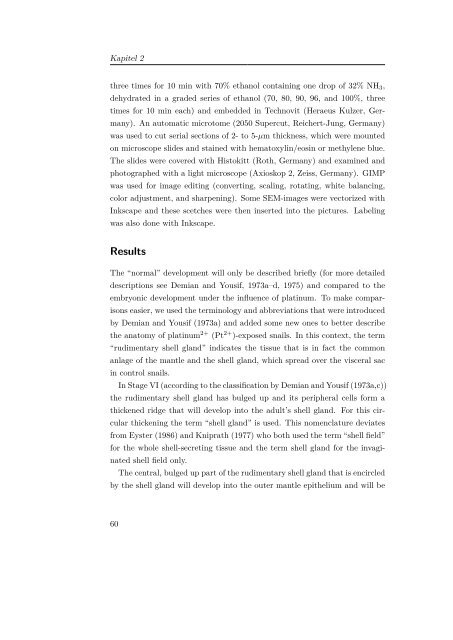Die Embryonalentwicklung der Paradiesschnecke ... - TOBIAS-lib
Die Embryonalentwicklung der Paradiesschnecke ... - TOBIAS-lib
Die Embryonalentwicklung der Paradiesschnecke ... - TOBIAS-lib
Create successful ePaper yourself
Turn your PDF publications into a flip-book with our unique Google optimized e-Paper software.
Kapitel 2<br />
three times for 10 min with 70% ethanol containing one drop of 32% NH 3 ,<br />
dehydrated in a graded series of ethanol (70, 80, 90, 96, and 100%, three<br />
times for 10 min each) and embedded in Technovit (Heraeus Kulzer, Germany).<br />
An automatic microtome (2050 Supercut, Reichert-Jung, Germany)<br />
was used to cut serial sections of 2- to 5-µm thickness, which were mounted<br />
on microscope slides and stained with hematoxylin/eosin or methylene blue.<br />
The slides were covered with Histokitt (Roth, Germany) and examined and<br />
photographed with a light microscope (Axioskop 2, Zeiss, Germany). GIMP<br />
was used for image editing (converting, scaling, rotating, white balancing,<br />
color adjustment, and sharpening). Some SEM-images were vectorized with<br />
Inkscape and these scetches were then inserted into the pictures. Labeling<br />
was also done with Inkscape.<br />
Results<br />
The “normal” development will only be described briefly (for more detailed<br />
descriptions see Demian and Yousif, 1973a–d, 1975) and compared to the<br />
embryonic development un<strong>der</strong> the influence of platinum. To make comparisons<br />
easier, we used the terminology and abbreviations that were introduced<br />
by Demian and Yousif (1973a) and added some new ones to better describe<br />
the anatomy of platinum 2+ (Pt 2+ )-exposed snails. In this context, the term<br />
“rudimentary shell gland” indicates the tissue that is in fact the common<br />
anlage of the mantle and the shell gland, which spread over the visceral sac<br />
in control snails.<br />
In Stage VI (according to the classification by Demian and Yousif (1973a,c))<br />
the rudimentary shell gland has bulged up and its peripheral cells form a<br />
thickened ridge that will develop into the adult’s shell gland. For this circular<br />
thickening the term “shell gland” is used. This nomenclature deviates<br />
from Eyster (1986) and Kniprath (1977) who both used the term “shell field”<br />
for the whole shell-secreting tissue and the term shell gland for the invaginated<br />
shell field only.<br />
The central, bulged up part of the rudimentary shell gland that is encircled<br />
by the shell gland will develop into the outer mantle epithelium and will be<br />
60
















